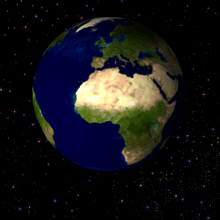day and night

rotation of the earth
The earth isn't just rotating around the sun but every 24 hours it also rotates around its own axis. This rotation causes day and night. All places on the same meridian have the same hour in the day. Drag the green point vertically on its meridian and define the latitude.
The yellow circle marks the parts of the earth where there's day and night. Drag the blue point on the equator and define the hour of all places on the green meridian. The passages through the yellow circle mark sunrise and sunset and the length of the day.
Modify the axial tilt by dragging the north pole. See how this affects the length of the day and the time of sunrise and sunset.
Apparently the sun arises every day in the east and follows a large arc in the sky. It reaches its highest altitude on midday and disappears behind the horizon in the west.
In reality it's the earth that rotates around its own axis in 23 hours 56 minutes and 4 seconden (= sidereal day). During this time earth is moving on its orbit, so we have to wait for another 3 minutes and 56 seconds until we see the sun at the same point as the day before. This makes exactly 24 hours. We call it a Solar Day.
The earth is moving in eastern direction. That's why we observe sunrise in the east. If you look from out in space upon the north pole, you can see the earth rotating counter clockwise. On the south pole you see it move in the opposite way.